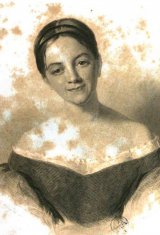Analysis of The Missionary
Letitia Elizabeth Landon 1802 (Chelsea) – 1838 (Cape Coast)
It is a glorious task to seek,
Where misery droops the patient head :
Where tears are on the widow’s cheek,
Where weeps the mourner o’er the dead.
These are the moments when the heart
Turns from a world no longer dear;
These are the moments to impart
The only hope still constant here.
That hope is present in our land,
For many a sacred shrine is there ;
Time-honoured old cathedrals stand ;*
Each village has its house of prayer.
O’er all the realm one creed is spread—
One name adored—one altar known :
If souls there be in doubt, or dread,
Alas ! the darkness is their own.
The priest whose heart is in his toil
Hath here a task of hope and love ;
He dwells upon his native soil,
He has his native sky above.
Not so beneath this foreign sky ;
Not so upon this burning strand ;
Where yonder giant temples lie, **
The miracles of mortal hand.
Mighty and beautiful, but given
To idols of a creed profane ;
That cast the shade of earth on heaven,
By fancies monstrous, vile, and vain.
The votary here must half unlearn
The accents of his mother-tongue ;
Must dwell ’mid strangers, and must earn
Fruits from a soil reluctant wrung.
His words on hardened hearts must fall,
Harden'd till God’s appointed hour ;
Yet he must wait, and watch o'er all,
Till hope grows faith, and prayer has power.
And many a grave neglected lies,
Where sleep the soldiers of the Lord ;
Who perish'd ’neath the sultry skies,
Where first they preached that sacred word.
But not in vain—their toil was blest;
Life's dearest hope by them was won ;
A blessing is upon their rest,
And on the work which they begun.
Yon city,*** where our purer creed
Was as a thing unnamed, unknown,
Has now a sense of deeper need,
Has now a place of prayer its own.
And many a darkened mind has light,
And many a stony heart has tears;
The morning breaking o’er that night,
So long upon those godless spheres.
Our prayers be with them—we who know
The value of a soul to save,
Must pray for those, who seek to show
The Heathen Hope beyond the grave.
* The Cathedral of Exeter.
** Triad Figure. Interior of Elephanta.—"The figure that faces the entrance is the most remarkable in this excavation, and has given rise to numberless conjectures and theories. It is a gigantic bust of some three-headed being, or the three heads of some being to whom the temple may be supposed to be dedicated. Some writers have imagined that it is, what they have called the Hindoo Trinity of Brahma, Vishnu, and Shiva ; and very strange historical conclusions have been deduced from this hypothesis. The Hindoo Trimurti, or Trinity, as it has been called, does not occupy a very remarkable place in the theology of the Brahmins ; the word Trimurti means three forms, and is applied to any three-headed figure."—Elliot.
*** Cawnpore.—“At this place, the excellent missionary, Henry Martyn, laboured for some months, in the years 1809 and 1810, both among the Europeans in the cantonments, and among the natives in the town. In the life of Martyn there is an account of his first effort to preach the gospel publicly to a mixture of the Hindoos and Mohammedans at Cawnpore. This attempt to make the word of God known to these people, seems to have had a peculiar blessing upon it ; and at times he drew together a congregation of eight hundred souls, who frequently burst into loud applause at what he said. Surely, the word of the Lord shall not return to him void.”—Elliot.
| Scheme | ABAB CXCX DEDE BFBF GHGH IDID JKJK FLXL MNMN OXOX PJPJ QFQF RXRX STST NUU |
|---|---|
| Poetic Form | |
| Metre | 110100111 110010101 11110101 11010101 11010101 11011101 11010101 01011101 111100101 110010111 1110101 11011111 11011111 11011101 11110111 01010111 01111011 11011101 11011101 11110101 11011101 11011101 11010101 01001101 100100110 11010101 110111110 11010101 011111 01011101 11110011 11010101 11110111 101101010 111101101 111101110 010010101 11010101 11010101 11111101 11011111 11011111 01010111 01011101 110110101 11010101 11011101 11011111 010010111 010010111 01010111 11011101 101111111 01010111 11111111 01010101 00101100 1100100110101100101010100010100110111010010110010111110101011111011010110111100011010101111111011001110010010101000101101110100011110011111111001001001000100101011111010111011010100 11110100100101011110010101001000100101000100111011101111101101010010101010111101110111111101111001010011011110100010111011100101101111110011011101111100 |
| Closest metre | Iambic heptameter |
| Characters | 3,434 |
| Words | 613 |
| Sentences | 29 |
| Stanzas | 15 |
| Stanza Lengths | 4, 4, 4, 4, 4, 4, 4, 4, 4, 4, 4, 4, 4, 4, 3 |
| Lines Amount | 59 |
| Letters per line (avg) | 45 |
| Words per line (avg) | 11 |
| Letters per stanza (avg) | 177 |
| Words per stanza (avg) | 42 |
Font size:
Submitted by Madeleine Quinn on September 27, 2016
Modified on March 05, 2023
- 3:05 min read
- 91 Views
Citation
Use the citation below to add this poem analysis to your bibliography:
Style:MLAChicagoAPA
"The Missionary" Poetry.com. STANDS4 LLC, 2024. Web. 27 Apr. 2024. <https://www.poetry.com/poem-analysis/45176/the-missionary>.


Discuss this Letitia Elizabeth Landon poem analysis with the community:
Report Comment
We're doing our best to make sure our content is useful, accurate and safe.
If by any chance you spot an inappropriate comment while navigating through our website please use this form to let us know, and we'll take care of it shortly.
Attachment
You need to be logged in to favorite.
Log In